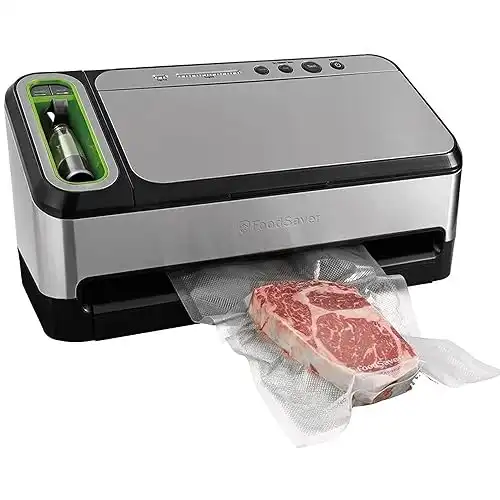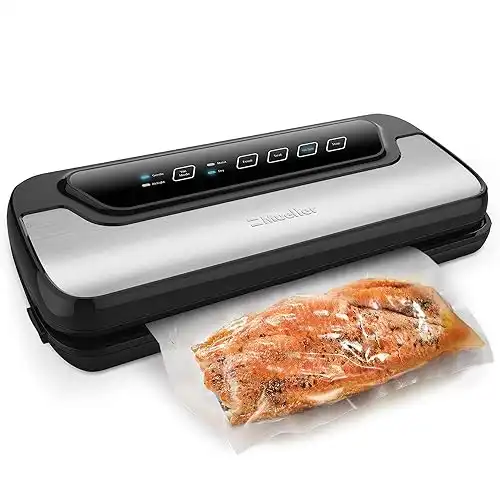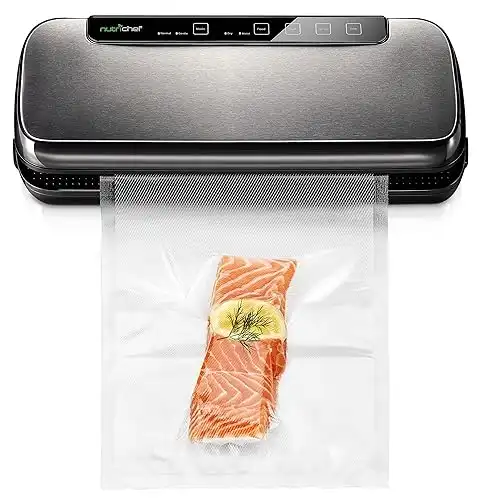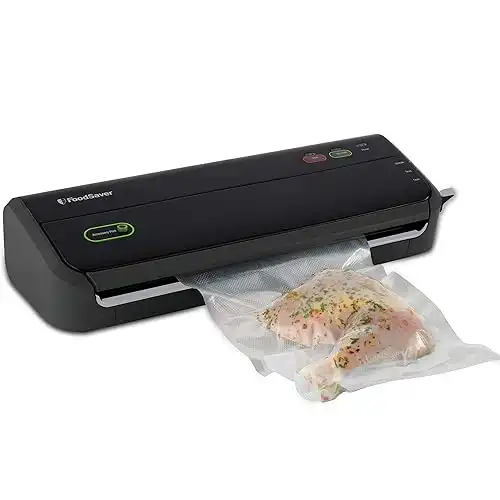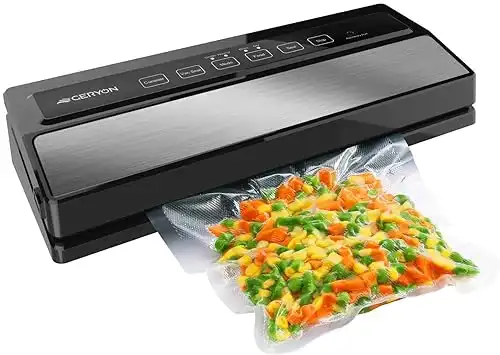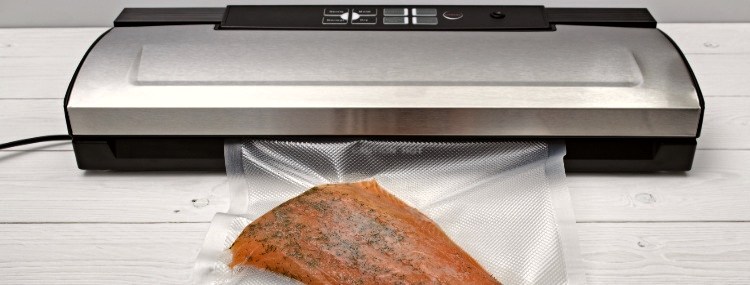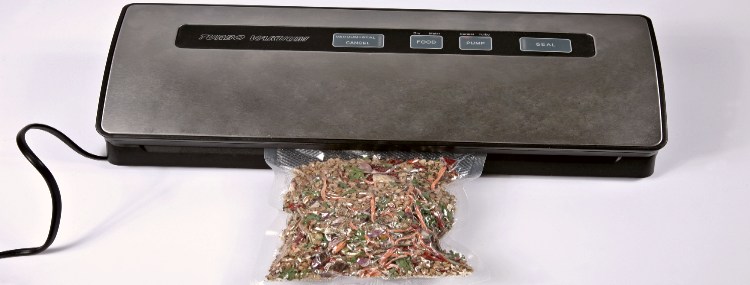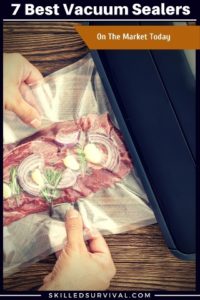
A Complete Guide To Finding (& Using) A Food Vacuum Sealer
Because nowadays, with SO MANY vacuum sealers on the market.
It’s overwhelming to find the best one for you.
And that’s a shame because they’re one of the best kitchen appliances.
Not only do they keep foods fresh longer, they also save a TON of money.
That’s why I sorted the good from the bad so you’ll end up with one you’ll happily daily.
TOPICS IN THIS GUIDE… ↓(click to jump)
- Best Vacuum Sealers Today
- What’s A Vacuum Sealer Anyway?
- Why Everyone Should Own One
- Best Vacuum Sealer Features
- How Long Does Sealed Food Last
- Bag Options (easy vs. expensive)
- How To Vacuum Seal Food Items
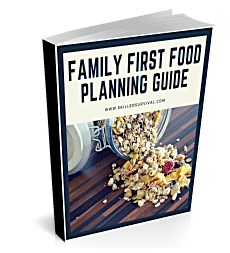
Want a free family-first food planning guide?
Enter your email below to instantly download this Complete Guide PDF. No purchase necessary. 👇 👇Best Vacuum Sealers To Stockpile & Save Money
Here are the best vacuum sealers we tested and researched on the market today:
The FoodSaver V4800 has automatic bag detection.
Put the bag in the vacuum chamber, and the machine does the rest to keep your food fresh and flavorful.
Its built-in rolled storage and cutter lets you make custom-sized bags. While LED light indicators easily guide you through the vacuum sealing process.
Plus, its smart technology automatically detects moisture.
So it will switch to the correct mode to ensure the proper airtight seal is achieved.
The patented drip tray that can be quickly taken out will catch any overflow liquid.
This feature makes this kitchen appliance easy to clean and maintain.
It's also considered a handheld vacuum sealer because it comes with a hose and wand.
The biggest downsides to this unit are it's expensive and a bit bulky for permanent counter storage.
↓ How To Use The Foodsaver Vacuum Sealer
A Mueller Sealer preserves by blocking the growth of mold, fungus, and bacteria.
These are the things responsible for ruining food's taste, appearance, and texture. And they can even cause acute illness as well.
The Mueller is made from durable ABS and features a high-powered suction element. And the heat sealing allows you to store your food in sturdy airtight bags.
Its stain-resistant housing will not absorb spills, and it's straightforward to clean.
Also, you can use it to reseal wine, oil, or vinegar. You can also use it to preserve jewelry to keep it shiny and polished.
The one big complaint with this unit is the downtime required between sealing. This unit required a 40-second downtime between vacuum sealing. This limitation can slow down your operations especially if you have a large batch of food to seal.
The NutriChef offers a fully automatic simple electric plugin design. With a control center placed on the top panel and a soft touch digital button along with an LED indicator light.
Also, it comes with a one-touch operation that allows you to select if you're sealing dry or moist food. The reusable and waterproof NutriChef bags protect the flavor, aroma, and texture.
Moreover, the auto one-touch operation delivers a user-friendly experience.
Plus, this one is both lightweight AND compact.
My two biggest gripes with these sealers are:
- You lose a good inch of the bag every time you seal/cut. This means over time, you end up paying for more bags...
- Customer service is not responsive for some...
↓ Vacuum Sealer By NutriChef Review
The FoodSaver FM2000 keeps food fresh up to 5X longer compared to other storage methods.
It comes with an innovative removal drip tray to make cleanup fast and easy.
It features easy-to-use manual operations to preserve a variety of foods.
Plus, it comes with an accessory hose, making it compatible with FoodSaver boxes.
For all the good ideas with this unit, it does have a couple of drawbacks, namely:
- The lid is so thick it leave a ton of space between the food and the seal. So you end up with the same amount of waste as other models, just on the other side of the seal.
- It's very loud during the sealing process
↓ Food Saver FM2000: First-Time Use
The Geryon Sealer removes air from specially designed bags. And its multilayer material heat seals to keep air out and prevent freezer burn. It reduces spoilage and food waste.
You can take off the upper lid to clean the sealer quickly and safely. Also, it fits up to 12-inch widths. Plus, it's designed with the full auto-seal operation. And includes soft-touch buttons and LED indicator lights.
It comes with two modes to ensure your food has the best possible preservation.
Of course, the biggest RISK with buying this unit is quality control. Some folks have ended up with a lemon from day 1. And some units seem to burn out after only a short time of usage.
It's cheaper but that reduction in cost seems to come with some risk.
What Is A Vacuum Sealer Anyway?
They work exactly how they sound.
They vacuum the air out of a bag and then seal it.
This air removal process compresses and preserves the items stored inside a bag.

Want a free family-first food planning guide?
Enter your email below to instantly download this Complete Guide PDF. No purchase necessary. 👇 👇Why Everyone Should Own One
Watch this video to see proof on WHY you should seal:
↓ Why Seal Your Food?
Investment / Save Money
My favorite prepping purchases are ones that pay for themselves.
And FOOD waste is one of the biggest there is.
Because the average US household wastes an estimated 76 billion pounds of food per year?
That’s an average per person of 238 pounds per year.
It’s 21 percent of the food purchased, and costs about $1,800 per year.
Most of the waste comes from:
- Fresh fruits (19%)
- Vegetables (22%)
- Dairy (20%)
- Meat (21%)
- And seafood (31%)
All while there’s starvation going on throughout the world…it’s pathetic!
But with a simple tool, at home cooks can reduce this problem.
A vacuum sealer devices preserves your food BEFORE it goes bad.
BEFORE it turns into waste.
That way, you can avoid preventable waste AND save thousands of dollars per year!
Win-win.
Saving money and saving the world.
Preparedness
It’s also one of the most affordable ways to stockpile food for an emergency.
In the past, I’ve written extensively about food storage…
For example:
- Best Home Freeze Dryers
- Best Food Dehydrators
- Top Survival Food Kits
- Best Non-Perishable Foods
- How To Make Pemmican
- How To Make Hardtack
- Mylar Bags – Food Storage’s Secret Weapon
- Canned Food Expiration Date Myth
Now, using a freeze dryer is the BEST way to stockpile food.
Why? Because freeze-dried foods can last decades!
How? Freeze dryers use extremely low temps and a vacuum chamber to remove ALL water content.
And without sacrificing texture, flavor, or nutrition.
But there’s one major drawback to Freeze Dryers…
They’re expensive as hell.
We’re talking over $2k (for the small models)!
So the upfront cost is too steep for most folks – myself included.
But you can get a vacuum sealer (with all the bells and whistles) for under $200.
And while freeze dryers remove moisture, these remove oxygen.
And without oxygen, bacteria (the stuff that spoils food) cannot survive.
So by removing oxygen (vacuuming), you stop food spoilage in its tracks.
Vacuuming, sealing, and properly storing food, provides shelf-stable foods for years.
And sometimes even decades!
That’s what preparedness is all about.
Accumulating healthy foods for an uncertain future.
They’re an essential tool to build a healthy food stockpile.
Waterproofing
Most people buy sealers to preserve food.
But that’s not all they can do.
For example:
You can vacuum seal matches for your bug-out bag.
Or you can seal your ammo before putting them into a survival cache.
Gear to put into a plastic bag and vacuum sealed protects it from water damage – genius!
Storage Compression / Saving Space / Organization
They also crush fabrics or jackets down in size.
This keeps your cramped closets organized and tidy.
For example:
My wife owns several down vests.
And those compress down to a fraction of the original size.
Sous Vide Cooking
Sous vide cooking is the process of:
- Sealing food in an airtight container (usually a vacuum sealed bag)
- And cooking that food in temperature-controlled water
In French, the term translates to “under vacuum,” which makes sense.
Chefs vacuum seal a protein with marinade, sauce, herbs, or spices and drop it in a large pot of water.
- There’s no contact with a heated metal surface.
- No contact with flames or steam or smoke.
- The water never comes to a boil.
↓ Sous Vide Cooking Beginners Guide
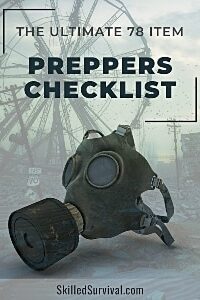
Want a free 78 item bug out bag checklist?
Enter your email below to instantly download this Complete Checklist PDF. No purchase necessary. 👇 👇Best Vacuum Sealer Features To Look For
Suction Power
Of course, suction power is important.
- You don’t want a wimpy sealer that struggles to remove all the air…
- Or takes forever to do so.
So compare suction power and if you’re stuck between two units…
Get the one with MORE power.
Automatic Bag Detection
Automatic bag detection makes life easier.
It allows you to add the tip of a bag to the mouth of the sealer, and the machine does the rest.
Auto means there are no levers or activation buttons to push.
Just feed the bag into the mouth of the machine, and it will begin sucking.
Accessory Hose
A hose attachment allows you to seal more than just plastic bags.
You can use specialty attachments to vacuum mason jars as well.
This feature makes your sealer more versatile.
Here’s an example of an accessory hose put to good use:
↓ How To Store Oatmeal In Mason Jars
Bag Storage Built-In
Another feature is a built-in bag storage.
Machines with this feature also tend to provide a slide cutter.
So you can pull the plastic out to any size you choose and cut it.
This is not only more convenient but helps eliminate waste.
How? By allowing you to custom-size the bags only to use the amount of plastic you need.
No more, no less.
Removable Drip Tray
Vacuum-sealing liquids can get messy.
Spills and drips are inevitable.
So look for a removal drip trays to collect this moisture to prevent spills.
That way, you can clean the tray without putting the entire unit in the sink.
“Seal Only” Button
Sometimes you want to heat seal a bag WITHOUT sucking.
This feature is handy if you create your own custom-sized bags.
When you pull a length of plastic off a roll and cut it, both ends will now be open.
Before you can suck, you must seal one of the bag’s ends first.
But you don’t want to suck yet.
So you need a “seal only feature” to do this.
And using bulk bag rolls saves you money and reduces waste.

Want a free 78 item bug out bag checklist?
Enter your email below to instantly download this Complete Checklist PDF. No purchase necessary. 👇 👇How Long Does Vacuum Sealed Food Last
It depends on:
- the type of food you’re trying to store
- how that food is prepared
- and what kind of bag you use to store it in
But if you’re storingL
- dry goods
- in Mylar bags
- using oxygen absorbers
The foods can last decades!
Awesome, but what about foods with moisture?
Well, if you do a good job dehydrating fruits and vegetables before storing, you can see impressive results.
Again, by removing moisture and air (oxygen) – mold, fungus, and bacteria cannot take root.
If those spoilers are blocked, the food will keep for a very long time.
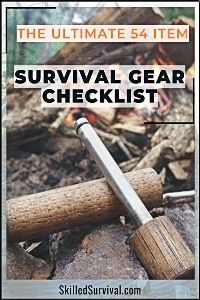
Want a free 54 item survival gear checklist?
Enter your email below to instantly download this Complete Checklist PDF. No purchase necessary. 👇 👇Best Bag Options (convenience vs. expense)
Most sealers come with their own set of bags.
And choosing the right type of bag is essential for success.
Due to the way vacuuming sealing works, you need micro gaps in the bag.
If you look closely, you’ll notice small bumps on the food storage bags.
These bumps are essential to the sealing process.
The bumps create small channels for the air suck through.
No bumps, no airway to suck the air.
This is why regular bags (without bumps) don’t work with vacuum sealers.
At least NOT without some sneaky tricks (we’ll get to shortly)…
In general, there are three types of bags people use:
- Specialty Bags
- Mylar Bags
- Ziploc Bags
Sealer Bags
These bags are the ones made explicitly for vacuum sealers.
They have small bumps on the bag.
But the bumps are not for looks.
The nodes allow air to suck through even when the bag is being held together.
If these bags did not have bumps, it wouldn’t suck.
Why? Because smooth flat plastic pressed together won’t suck air.
These are the best bags to use for everyday use.
But these bags are not ideal if your goal is extreme long-term storage…
For that, you should choose Mylar bags.
Mylar Bags
Mylar bags are non-porous and remain completely sealed for years and perhaps decades.
But because it’s so smooth, it’s difficult to draw air out of a Mylar bag using a vacuum sealer.
To make these bags work, you must add a small strip of specialty plastic to create a channel for the air to suck through.
Here’s a video showing this cost-effective and straightforward method in action:
↓ How To Vacuum Seal Food In Mylar Bags
Ziploc Bags
Everyone knows Ziploc bags, and they do make a “ziploc” version of the plastic vacuum seal bags.
And the reason we all love ziploc bags is because of their extreme convenience.
But, standard zip locks are not made with vacuum sealers in mind.
And the specialty ones are cost-prohibitive.
So, if you’re interested, there is a way to use regular zip locks.
Yes, it does take more steps.
But it’s not too bad if you’re interested in savings.
↓ Vacuum Seal Ziploc Freezer Bags

Want a free 78 item bug out bag checklist?
Enter your email below to instantly download this Complete Checklist PDF. No purchase necessary. 👇 👇How To Vacuum Seal Different Foods
Man! There are a TON of resources available on “how-to” vacuum seal “just-about-anything.”
I’ve spent hours founding the best videos.
And I’m going to share them ALL below:
How To Vacuum Seal Meat
Many people like to bulk store meat in their freezers.
This makes sense because if you do it right, you’ll eliminate freezer burn.
And the meat will taste fresher when you’re ready to eat it.
↓ How To Vacuum Seal Your Meat
How To Vacuum Seal Avocados
I don’t know how many avocados I’ve lost over the years…
These suckers go bad in just a couple of days.
So buying them in bulk is risky.
But not if you vacuum seal them!
↓ How To Save Avocados!
How To Vacuum Seal Your Favorite Fish And Wild Game
This video shows you how to prep and season your wild game for vacuum sealing:
↓ How To Vacuum Seal Fish & Wild Game
How To Vacuum Seal Soup
Liquids often end up on lists of:
- Foods should you not vacuum seal
And while Soups are tricky to vacuum seal they’re not impossible.
Check out this video to learn how:
↓ How To Vacuum Seal Soup & Liquids
How To Vacuum Seal Bread & Hamburger Buns
Sealing bread (especially soft pieces like buns) can be a challenge…
IF you don’t know what you’re doing.
Most people end up with squished bread that’s flat as a pancake.
Not good.
So instead, watch the video below to see how easy it can be:
↓ Preserving Bread With A Vacuum Sealer
How To Vacuum Seal Moist Foods
Vacuuming and sealing moist foods can be messy.
That’s why most sealers come with drip trays.
But if you get the right bags, you can eliminate this headache altogether!
↓ Vacuum Sealing Moist Delicate Foods
How To Vacuum Seal Flour For Long-Term Storage
↓ Vacuum Sealing Flour For Long Term Storage
Does Sealing Speed Up Marinating?
Negative air pressure helps to pull a liquid into the meat.
Soft Foods
Lots of people make a mistake trying to vacuum seal soft foods…
I’m talking about blueberries, soft cheeses, breads, etc.
Why? Because they get smooshed, squished and ruined during the process.
But there is a sneaky trick to get around this dilemma.
Freeze these items BEFORE vacuum sealing.
This gives them more rigidity so you can suck the air out without crushing them.
↓ How Do I Vacuum Seal Soft Foods?

Want a free family-first food planning guide?
Enter your email below to instantly download this Complete Guide PDF. No purchase necessary. 👇 👇Items You Should Already Be Sealing
Check out this excellent video from Canadian Prepper if you’d rather watch:
↓ 17 Prepping Items To Vacuum Seal For SHTF
1. Food
Meats, Veggies, Fruits, Snacks, You Name it…
You Can Probably Vacuum Seal IT!
2. Water
I store water in Legacy Premium 5 Gallon Stackable Containers.
Some people buy canned water instead.
Another alternative to expensive canned water is to vacuum seal some in Mylar bags.
You can filter water before and store it in a safe location.
It’ll remain safe and delicious until the day you need it.
3. Toilet Paper, Towel, Wipes
In a pandemic, everyone realizes how critical TP is for everyday life.
That’s why people now stock up to prevent being caught off guard.
But here’s the problem:
What if your TP stash gets ruined from a flood or a pipe leak?
Plus, stockpiling TP takes up a ton of space.
So to fix both of these issues, vacuum seal your TP.
This will compress it (to save space) AND make it waterproof!
This strategy makes sense to me.
Note: Any thin fabric or cloth will compress to a smaller size when air is removed.
4. Batteries
You should waterproof your batteries.
This is especially true IF you pack batteries in your survival pack or bug-out bag.
Vacuum sealing keeps them safe and prolongs their shelf life.
5. Fire Starting Kit
There’s nothing more demoralizing than showing up at your campsite you and can’t make a fire.
This can happen if your survival lighter or survival matches become soaked.
They become useless.
No spark, no fire, no heat, no cooking…bummer
So put your matches and lighters in a plastic bag and vacuum seal them; making them waterproof.
6. Ammunition
If you’re into preparedness you know how important ammo is.
And usually, I’d suggest using ammo cans with good seals (plus oxygen absorbers).
But what if you want to bury some ammo in a survival cache?
Well, in this case, vacuum seal your ammo to prevent rusting.
↓ Vacuum Sealing Ammo – How Did It Hold Up?
7. Medication
If you want your meds to last, get them out of those pill bottles.
Instead, use Mylar bags to seal those meds for the long haul.
8. First Aid Kits
Small first aid kits are not waterproof.
But these kits that are best for your survival pack, bug-out bag, or get-home bag.
But downpours or river crossings can put all your gear at risk.
So waterproof that bad boy using plastic bags.
9. Sharpie Markers / Pens
Ink will eventually dry.
So seal a few, and you’ll know you’ve got the power of the pen no matter what the future holds.
10. Spices
Spices can lose flavor over time.
They won’t “spoil,” but what good is a spice that has little or no flavor?
Instead, save that flavor profile by using chamber vacuum sealers.
10. Hand Crank Radio
If you use Mylar bags for storage, you’re creating a mini Faraday bag.
An EMP electrical pulse will go around the foil of Mylar and protect the devices within.
So add a hand-crank radio (or any electronic device) to a Mylar bag and seal it.
12. Firearm
Again, survival caches are known to be exposed to moisture…
No matter how well you seal the container.
And if you store ammo in your survival cache, you might add a firearm to go with it.
So suck out the air and wrap it up!
13. Seeds
Seeds are powerful, especially in a doomsday scenario.
A seed can equal an abundance of food and nutrition.
They have extreme value in a barter economy.
So protect that investment by sealing them up.
14. Documents / Photos
You can seal your documents or laminate them.
Both of these techniques protect critical documents from water damage.
So if you’re worried about flooding– vacuum seal your docs.
15. Socks/Underwear/Tee-shirts
You should take one change of undergarments in your bug-out bag.
I put them in a skivvy roll to keep them organized and compact.
However, you can compress these “small clothes” even more.
AND make them waterproof.
Final Thoughts
A vacuum sealer is a wise investment.
Especially if you’re into preparedness.
Because when you store foods without moisture or air, they last longer.
This prevents unnecessary waste and builds valuable food stockpiles.
Saving money AND become more resilient?
Absolutely!
Why Trust Skilled Survival...
Go here now to review a full breakdown of:
- Who We Are
- Our Credentials
- Our Mission
- & Product Recommendations...
Here are a few highlights of our teams credentials & certifications:
- Certified Member of a Mountain Search & Rescue Organization
- Plant Emergency & Safety Leader for a Major Food Manufacturer
- Member of the 10TH Mountain Division Hut Association
- Certifications: Avalanche 1, WFR, CPR
- Official Gear Tester for Numerous Outdoor Gear Companies
- Countless Multiday Backpacking trips into Remote Wilderness
- Bachelor's Degree In Mechanical Engineering
- Bachelor's Degree In Civil Engineering
- Bachelor's Degree In Biomedical Engineering
"It takes 20 years to build a reputation and five minutes to ruin it." - Warren Buffett
We're fully aware that trust is NOT something you GET but is EARNED.
And we'll continue to earn YOUR trust through our forthright and honest approach with each new Blog Post, Guide & Product we create...
Prepare, Adapt & Overcome,

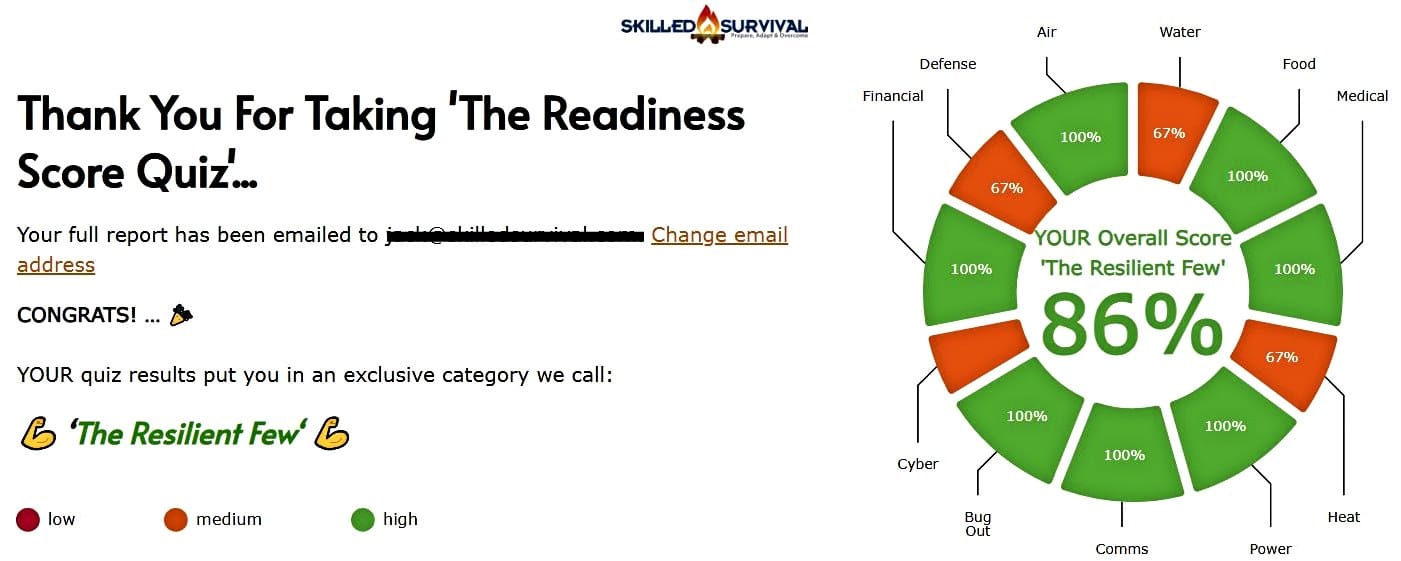
AND... I've still got a few gaps in my preps...🤔 But at least, I'm not part of 'The Fragile Masses'. 👍 Find out where YOU stand by answering a few questions...

Recommended Reading
7 Best Camping Generators For Whisper Quiet Power
You need quiet power for both camping and survival. In this article, I share the best camping generators and how to modify them for silence.
10 Best Hand Crank Generators For Backup DIY Power
Crank generators are a wise black-out backup tool. We show you the best ones to keep your family safe in a long term power outage.
9 Best Solar Radios Hand-Picked By A Survival Expert
Everyone needs a solar radio for life-saving weather alerts and emergency information. We share the best solar radios on the market today.
9 Best Survival Bags Hand-Picked By Our Gear Expert
Settling on the RIGHT survival bag can be an overwhelming task. But we make it easy by focusing on only the best ones available today.
Best Portable Power Stations For Luxurious Camping Or Survival
We review the best portable power stations on the market. And break down the features you'll want for camping, traveling, and emergencies.
Bluetti AC200P Review: Putting It To The Ultimate Test
We put the Bluetti AC200P power station through its paces as a backup emergency solar generator and a portable camping generator.
